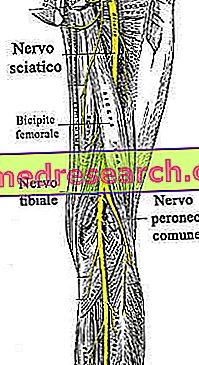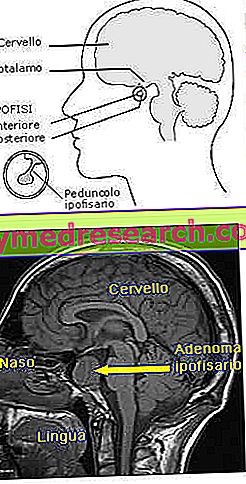Generality
The sciatic nerve, or ischial nerve, is the largest and longest nerve in the human body, which begins in the lower part of the back and covers the entire lower limb, including the foot.

A very well known pathology that arises due to a compression of the sciatic nerve is sciatica or sciatica.
Short reminder of what a nerve is
To fully understand what a nerve is, it is necessary to start from the concept of neuron .
Neurons represent the functional units of the nervous system . Their task is to generate, exchange and transmit all those (nervous) signals that allow muscle movement, sensory perceptions, reflex responses and so on.
Typically, one neuron consists of three parts:
- A body, where the cell nucleus resides.
- The dendrites, which are equivalent to receiving antennas of nerve signals generally coming from other neurons.
- Axons, which are cellular extensions having the function of spreading the nervous signal. The axon covered with myelin (myelin sheath) is also called nerve fiber .
A bundle of axons forms a nerve .
Nerves can carry information in three ways:
- From the central nervous system (CNS) to the periphery . The nerves with this property are called efferent. The efferent nerves control the movement of the muscles, so I am in charge of the motor sphere.
- From the periphery to the CNS . Nerves with this capacity are called afferent. The afferent nerves signal to the CNS what they detected in the periphery, therefore they cover a sensitive (or sensory) function.
- From the SNC to the periphery and vice versa . Nerves with this double capacity are called mixed. Mixed nerves have a dual function: motor and sensory.
What is the sciatic nerve?
The sciatic nerve, or ischial nerve, is an important nerve of the human body, which begins in the lower part of the back, traverses the entire lower limb posteriorly and ends at the level of the foot.
Among the nerves present in the human body, it is the longest and the largest in terms of width.

From the site: healthyfoodhouse.com
Anatomy
The sciatic nerve is a derivation of the last two lumbar spinal nerves (L4 and L5) and of the first three sacral spinal nerves (S1, S2, S3).
Involved in the formation of the so-called lumbosacral plexus, these fibers converge in a single structure - precisely the sciatic nerve - in front of the piriformis muscle . Located in the area of the buttock, between the inside and the outside of the pelvis, the piriformis muscle connects the front face of the sacrum with the large trochanter of the femur.
In projecting below the piriformis muscle, the sciatic nerve passes through the large ischial hole and begins, from here, to develop along the whole lower limb, posteriorly.
Up to the popliteal cavity (posterior part of the knee), it passes to the shoulders of the great adductor muscle and in front of the long head of the biceps femoris muscle . The biceps femoris is a muscle of the thigh with a posterolateral seat, which forms, together with the semimembranosus and semitendinosus, the so-called group of ischiocrural muscles .
Thus, at the level of the popliteal fossa, the sciatic nerve is subdivided into two branches (ie branches):
the tibial nerve and the common peroneal nerve .
- The tibial nerve runs through the posterior compartment of the leg up to the foot.
- The common peroneal (or fibular) nerve stands out towards the anterior and lateral areas of the leg and foot.
In turn, both the tibial nerve and the common peroneal nerve give rise to other further branches. Together they form the so-called sural nerve ; individually, the tibial nerve forms the medial plantar nerve and the lateral plantar nerve, while the common peroneal nerve is divided into superficial peroneal nerve and deep peroneal nerve .
| The sciatic nerve and the two branches, or branches. | ||
| Sciatic nerve | Tibial nerve | Sural nerve Medial plantar nerve Lateral plantar nerve |
| Common peroneal nerve | Sural nerve Superficial peroneal nerve Deep peroneal nerve | |
SHORT REVIEW OF SPINAL NERVES
Present in pairs, the spinal nerves of the human body are 31 pairs .
These important nerve structures originate in the spinal cord - which is one of the two main components of the central nervous system (the other being the brain) - and present both nerve cells with sensory function and nerve cells with motor function. Thus, according to the definitions given at the beginning of the article, the spinal nerves are mixed nerves.
To simplify the anatomical study, the doctors considered it appropriate to divide the 31 pairs of spinal nerves into 5 groups: the 8 cervical spinal nerves, the 12 thoracic spinal nerves, the 5 lumbar spinal nerves, the 5 sacral spinal nerves and, finally, the coccygeal pair.
Looking at the image below, we can see how the name of the spinal nerves derives from the region of the vertebral column from which they come out (and not from the area of spinal cord from which they originate).
Functions
Deriving from certain spinal nerves (which are mixed nerves), the sciatic nerve has a sensory function and a motor function . In fact, it is in charge of controlling some precise cutaneous regions and some specific muscles of the lower limb.
MOTOR FUNCTION
At the level of the buttock, the sciatic nerve does not supply any muscle. In fact, his muscular innervations begin from the thigh. Here, the posterior muscles ( ischiocrural muscles ) and the large adductor muscle innervate.
Lower down, at the point where it splits in two, it makes contact with all the muscular elements of the leg and the intrinsic muscular elements of the foot.
To be more precise:
- The tibial nerve innervates the posterior muscles of the leg (those of the calf) and a part of the intrinsic muscles of the foot.
The innervation of the intrinsic muscles of the foot occurs by means of the medial and plantar lateral plantar nerves.
- The common peroneal nerve innervates the anterior and lateral muscles of the leg and the remaining intrinsic muscles of the foot.
The deep peroneal nerve makes contact with the anterior muscles of the leg and with part of the intrinsic ones of the foot, while the superficial peroneal nerve establishes the innervation with the lateral muscles of the leg.
| The main muscles innervated by the tibial nerve, together with its branches, and the common peroneal nerve, together with its branches. | |
Nerve | Muscle |
| Tibial nerve | popliteal gastrocnemius Soleo Long flexor fingers Long flexor of the big toe Short finger flexor Short flexor of the big toe Posterior tibial Big toe abductor Hallux adductor |
| Common peroneal nerve | Anterior Tibial Long finger extender Long toe extender Short finger extender Hallux short extensor |
SENSITIVE FUNCTION
Premise: the sensitive nerve fibers of the spinal nerves have the task of sending, to the spinal cord, the information that they collect at the periphery of the body, precisely at the skin level.
Information is collected through the dermatomers ; dermatomes are highly specialized areas, with tactile, proprioceptive, temperature-sensitive and nociceptive properties.
The terms "thermosensitive" and "nociceptive" mean, respectively, "that they are able to capture temperature variations" and "that they are capable of picking up painful stimuli".
At the skin level, the sciatic nerve presents only indirect sensory innervations, which establishes through its two main branches and the branches of these:
- The tibial nerve innervates the postero-lateral compartment of the leg (hence from below the popliteal cavity) and the entire plantar surface of the foot (ie the sole).
The innervation of the plantar surface of the foot occurs through the work of the medial and plantar lateral plantar nerves.
- The common peroneal nerve innervates the anterolateral compartment of the leg and the entire dorsal surface of the foot.
Specifically, the superficial peroneal nerve contacts the anterolateral skin of the leg and the dorsal skin of the foot, while the deep peroneal nerve makes contact with the dorsal region located between the big toe and the second toe.
- The sural nerve (which is remembered to be a derivation of some branches of the tibial nerve and the common peroneal nerve) innervates the posterolateral cutaneous region of the leg and the lateral region of the foot, calcaneus and ankle.
Diseases of the Sciatic Nerve
The main pathology related to the sciatic nerve is - as many readers will already know - sciatica, also known as sciatica .
Sciatica is the name that doctors use for any painful condition, following a process of compression or irritation of the sciatic nerve.
Typically, an individual with sciatica perceives pain in the lower back, buttock and leg (which are the regions covered by the sciatic nerve).
Moreover, he often also complains about a series of secondary symptoms, such as: muscle weakness, tingling in the leg and difficulty, more or less marked, in controlling the movements of the affected lower limb.
Usually, the compression / irritation that produces the symptoms of sciatica affects the spinal nerves constituting the sciatic nerve, ie the lumbar L4 and L5 and the sacral S1, S2 and S3. The typical causes of compression / irritation are:
- Spinal disc herniation . According to some statistics, it would be responsible for 15% of sciatica cases
- The degenerative discopathy of the low back area .
- Spinal stenosis of the lumbar-sacral tract .
- Spondylolisthesis
- Piriformis syndrome . To decree the process of compression / irritation is the piriformis muscle (this explains the origin of the name of the aforementioned circumstance), which is in close contact with the sciatic nerve near the point of emergency of the latter.
Often, the piriformis muscle compresses or irritates the sciatic nerve after having suffered a trauma or a contracture.
- Spinal tumors . It is the mass effect, following the continuous growth of the tumor, which determines the symptoms. In fact, by getting bigger, spinal neoplasms can push on the spinal nerve roots or on the spinal cord itself.

To learn more about the characteristics of sciatica (symptoms, diagnosis and therapy), it is advisable to consult the article here.
Note: in general sciatica is a unilateral disorder; it is very rare for an individual to suffer from double compression / irritation of both sciatic nerves.
LESION OF SCIATIC NERVE
Another important condition that can affect the functioning of the sciatic nerve is the lesion against it.
The main cause of injury to the sciatic nerve is hip replacement (or hip arthroplasty ).
Based on the latest statistical research, hip arthroplasty operations that end with sciatic nerve damage would be between 0.5 and 2%.



